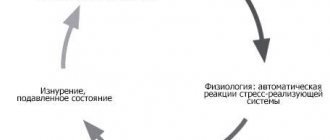Sociometry in psychology is a method for studying interpersonal relationships in a group. The author of the direction is J. Moreno. The psychotherapist has developed both a separate technique with a similar name for studying groups, and an entire direction. In a broad sense, sociometry is a set of methods for studying relationships in a group. Let's take a closer look at what sociometry is, when and what it is used for, and how to use sociometric research correctly. We will also define the basic concepts and procedures of the sociometry method.
Definition of the concept
The name “sociometry” is derived from two Latin words: socius, which translates as “comrade, companion, accomplice”, and metrim, which means “measurement”. Thus, literally “sociometry” is translated as “measurement of accomplices.” Sociometry is an applied science that is based on psychological, sociological teachings and does not have a unique status.
Who developed the sociometry method? The author of the theory and research methodology is psychologist, sociologist and psychiatrist J. Moreno. The researcher believed that all social problems can be solved by regulating relationships between people. However, for this it is necessary to determine the nature of interpersonal and intergroup relations. For this purpose, the sociometry method was created. Sociometry is based on group psychotherapy.
What process is sociometry used to study? Sociometry is a method of psychological research that is used to describe and study interpersonal relationships in a team. Sociometry allows you to collect primary information about a small social group for further analysis. The cause of the conflict, according to sociometry, is the difference in people’s beliefs and contradiction in emotional relationships.
Interesting! Moreno first used the concept of “sociometry” while working in a refugee camp. Then the psychologist suggested that fewer conflicts and contradictions would arise between people if they were settled not chaotically, but according to nationality, religious and political beliefs, and other interests.
Theoretical basis
The term “sociometry” arose at the end of the 19th century. in connection with the description of possible ways to measure the social influence of some groups of people on others. The theoretical and ideological justification for sociometry as a method of cognition and measurement of social phenomena was given by J. (J. L. Moreno). First, sociometry is a general theory of social groups; secondly, sociometry means any measurement of all social relations; thirdly, sociometry is the mathematical study of the psychological properties of the population, experimental techniques and results obtained by applying quantitative and qualitative methods. The object of sociometric theory is actually existing small social groups that have sufficient experience of living together in group life. The subject area of sociometry is the emotional relationships of people in groups (likes, dislikes, indifference). Created on the basis of the views of K. Marx, O. Comte and Z. Freud, sociometry is opposed to both behaviorism, which observes only the external behavior of people, and Freudianism, with its emphasis on the internal, deep processes of human behavior. According to Moreno, the emotional relationships of people in groups represent an atomistic structure, the structure of society, which is inaccessible to simple observation and can only be revealed with the help of social microscopy. “Microsociology,” wrote Moreno, actually arose with the advent of my theory of “social microscopy.” In combination with sociometric techniques, it laid the foundation for the theoretical and practical foundations of microsociology.” The study of the "primary atomistic structures of human relations" was seen by Moreno as "the preliminary and necessary basic work for most macrosociological research." One of the central concepts of this theory is the body, a term meaning the simplest unit of feeling transmitted from one individual to another, which determines the number and success of interpersonal relationships in which they enter.
The essence of the “general theory of sociometry” is the assertion that social systems are attractive-repulsive-neutral systems, including not only objective, externally manifested relationships (macrostructure), but also subjective, emotional relationships, often invisible externally (microstructure). The goal of sociometric theory is to formulate the laws of emotional relationships in groups.
Basic provisions of Moreno's theory
- The social atom of society is not the individual, but their coexistence;
- Law of Social Gravity: The cohesion of a group is directly proportional to the attraction of the participants to each other;
- Sociological law: the highest forms of collective organization develop from simple forms;
- Sociodynamic Law: Within some groups, human attachments are distributed unevenly.
The purpose of sociometry
The purpose of sociometry as a research method in psychology is to improve and optimize the interaction of those individuals who are part of the group being examined. Objectives of sociometry:
- Determine the degree of cohesion or disunity between team members.
- Identify authoritative people, likes and dislikes within the group.
- Discover mini-unions within a large team, led by informal leaders.
Sociometry is resorted to if there are noticeable signs of an unfavorable psychological climate in the team, disunity of participants, conflicts, contradictions, decreased performance and productivity. The data obtained during sociometry can be used for further restructuring of the team. The overall result and achievement of common goals depends on the cohesion of the group.
Important! Sociometry indicates likes and dislikes within a team, but does not name specific problems. To more accurately determine psychological problems and eliminate them, it is necessary to use additional diagnostic techniques, for example, conversation, surveys, projective tests.
Sociometric theory of J. Moreno
The young doctor Jacob Moreno Levi began his research during the First World War in a refugee camp near Vienna. He noticed that the effectiveness of people’s interactions depends on who they are currently in contact with. In some cases, communication is colored by positive emotions, and people interact with pleasure, in others, the effect of rejection arises, and partners literally lose everything.
Based on observations, Moreno came to the conclusion that society is subject to the same laws of attraction and repulsion as the physical world. Therefore, in any community there are people who are drawn to each other and strive to unite in microgroups of 3-4 people. These micro-groups play an important role in the functioning of the entire community. His life is also greatly influenced by those individuals who have the gift of attraction and who are sympathized with other members of the group.
Having emigrated to the USA, J. Moreno continued his research at a specialized school for juvenile delinquents, and then even opened the Sociometric Institute. By the mid-40s, Moreno’s teaching had fully taken shape, and the author himself distinguished three directions in it: sociometry, sociodrama and psychodrama.
Theses
Key provisions regarding the methodology for studying interpersonal relationships using sociometry:
- All of humanity is a single structured unit, since all people are interconnected and influence each other.
- Under no conditions or methods can it be possible to completely objectively assess the existing reality, since it consists of many subjective realities. Each person has his own point of view regarding the processes taking place in the world and in the team.
- It is advisable to conduct research in a group that is united by a common activity (another criterion) for at least six months.
- Each member of the group must clearly and accurately understand the criterion put forward for the study.
- The research is carried out by an outsider; for example, you can invite a freelance psychologist. However, at the same time, the sociometrist must become part of the diagnostic team.
- Sociometric research helps to understand the nature of relationships in a group, but it does not indicate the reasons and motives for people’s behavior.
It is necessary to study the characteristics of the group in advance and decide on a set of methods for sociometry. Think about the purpose of the study. It will be good if you cover the same problem from different angles and analyze it using different formulations of questions. This will give more accurate results and will help to recognize the insincerity of participants if something happens.
Content
- 1 Description of the technique
- 2 Theoretical foundations
- 3 History of creation
- 4 Procedure 4.1 Stage 1
- 4.2 Stage 2
- 4.3 Stage 3 4.3.1 Non-parametric procedure
- 4.3.2 Parametric procedure
- 4.4.1 Example of a sociometric card
- 4.5.1 Instruction options
- 5.1 Sociometric matrix
- 7.1 Options for sociometric criteria (Questions)
Sociometric procedure
What is the sociometry method? Sociometric research is carried out in small groups (12–15 people). A small group is an entity in which people are united according to some criterion, type of activity or conditions of existence. Sociometric research is carried out in two types of groups:
- Membership group. In this case, people are formally united. For example, a work team.
- Reference group. In this case, people are united by some kind of interest, business, that is, all participants are significant to each other. For example, a group of friends, a subcultural association.
In addition, the following types of groups can be distinguished:
- diffuse (based on likes and dislikes);
- association (each participant pursues personal goals);
- corporation (group pursues antisocial goals);
- team (each participant is interested in achieving personal and common goals).
Why are we talking about this? Because the type of group is important for analyzing and evaluating the results of a sociometric study.
History of creation
Applied sociometry in the form of a special survey and data processing technique (sociometric test, sociomatrices, sociograms, sociometric indices) was developed in research on the elimination of various conflicts in small groups. It has been widely used among sociologists and social psychologists in many countries around the world. Modern sociological and socio-psychological studies of small groups and primary (contact) groups almost always include sociometry as a main or additional method.
Diagnostics
The main means of sociometry is the technique of the same name. However, for the most complete picture and accurate result, it is recommended to use other tools. For example, you can refer to the Leary questionnaire (1957). Like the classical technique of sociometry, it diagnoses interpersonal relationships in a group and the properties of each of its participants.
The Leary Questionnaire identifies 8 personality types:
- authoritative and leading;
- self-centered;
- straightforward-aggressive;
- skeptical;
- obedient;
- dependent-obedient;
- cooperating;
- patronizing.
In addition, based on the results, you can obtain the characteristics of each person on two scales:
- independence and dominance or dependence and submission;
- benevolence and love (emotional acceptance) or aggressiveness and hatred (rejection).
Each participant is asked to respond to 128 statements. The researcher then analyzes the responses and presents the final results in tabular and graphical form.
In addition to the Leary questionnaire, you can use other diagnostic techniques for sociometric research, for example, the following:
- Study of the level of empathy tendencies, author – I.M. Yusupov. Each survey participant answers 36 statements.
- “Choice in Action”, author – Ya.L. Kolominsky. This technique is often used to diagnose preschool groups.
- “Leader”, author – R.S. Nemov. A person has to answer 50 questions. Based on the results of the study, we can say how well each of the respondents corresponds to the role of leader.
- Assinger Questionnaire. Helps determine how correct a person is in communicating with other team members, and whether he easily finds a common language.
- OMO (Interpersonal Relations Questionnaire), author – A.A. Rukavishnikov. Characterizes the characteristics of human behavior from the point of view of satisfying the basic needs of the individual in the group.
- Other. There are dozens of auxiliary psychology methods for sociometry.
The origin and development of the sociometric experiment
The sociometric method was created in the 30s. XX century American psychiatrist and sociologist J.L. Moreno, he also introduced the concept of “sociometry,” which means measuring the dynamics of interpersonal relationships between members of one group. According to the author himself, the essence of sociometry lies in the study of the internal structure of social groups, which can be compared with the nuclear nature of an atom or the physiological structure of a cell. The theoretical foundations of the sociometric method are based on the fact that every aspect of social life - political, economic - is easily explained by the state of emotional relationships between individuals. Specifically, this can be expressed in people’s manifestations of antipathy and sympathy for each other. That is, the author of the sociometric method believed that changes in psychological relationships in small groups directly affect the entire social system. Today this method has many modifications.
Bulgarian sociologist L. Desev identified three areas of research in which sociometric methods are used:
- Dynamic or “revolutionary” sociometry, the subject of study of which is the group in action (J. L. Moreno and others).
- Diagnostic sociometry, which classifies social groups (F. Chapin, J. H. Criswell, M. L. Northway, J. A. Landberg, E. Borgardus, etc.).
- Mathematical sociometry (S. C. Dodd, D. Stewart, L. Katz, etc.).
Soviet psychologists who made a great contribution to the implementation of this method were I. P. Volkov, Ya. L. Kolominsky, E. S. Kuzmin, V. A. Yadov and others.
According to Ya. L. Kolominsky, the psychological basis for the study of relationships is the knowledge that the desire of one person for another comes from the desire to be closer to the object of affection. Moreover, expression in verbal form should be recognized as a significant real indicator of not only understanding, but also the overall presence of a need in a person.
How is sociometric research carried out?
Sociometric research is based on a sociological survey. The survey procedure itself consists of several stages.
How to conduct sociometry:
- Preparation. It is necessary to determine the subject, object, goals and objectives of the study. And also at this stage you need to collect as much information as possible about the group as a whole and about each individual participant.
- Warm up. This stage involves meeting with the group, establishing trusting contact, and explaining the criteria for the study.
- The survey itself. The presenter gives brief instructions to the subjects, distributes diagnostic materials, gives time to fill out forms, and collects materials.
- Processing sociometry results. The researcher evaluates the answers and checks them for validity and reliability.
- Results. The researcher interprets the results and makes recommendations for improving the climate in the group, changing its structure, etc.
The list of questions is compiled on an individual basis. Each question should reflect a situation that is relevant and understandable to group members. For example, when diagnosing a sports team, questions may be related to training, victory celebrations, away competitions, changes in team composition, etc.
The criteria are:
- formal and informal (business and personal relationships);
- double and single (relations between colleagues and in the “superior-subordinate” system);
- prognostic (how adequately an individual participant perceives the nature of the existing relationship);
- significant and insignificant (deep, stable relationships and superficial relationships).
Conditions for selecting criteria:
- limited (maximum 8–10);
- logical connection between all criteria and questions;
- the significance and interest of the criteria for group members;
- clarity of criteria for group members;
- maximum specifics and examples based on real situations.
All criteria are written in a column; opposite each question, the test taker will have to put his choice (surnames or pre-agreed numbers of group members).
Example of a sociometric card:
| № | Type | Criteria | Elections |
| 1 | Job | Who would you choose as a foreman? | |
| Who would you never choose as a foreman? | |||
| 2 | Leisure | Who would you like to invite to your New Year's Eve party? | |
| Who would you like to invite to New Year's Eve? |
As for the answer options, there are two types of research: with a limited number of choices (parametric form of sociometry) and with an unlimited number of choices (nonparametric). The method of selection must be discussed in advance with the survey participants.
If the choice is limited, then respondents are immediately asked to answer the continuation of each of the statements: “And if this person is not available, then who?” This question is repeated as many times as what is the limit of restrictions. Psychologists recommend using 4–5 choices for a group of 22–25 people. With a nonparametric approach, a person may not make a choice at all or choose at least all the remaining members of the team (except himself). From the point of view of accuracy and reliability of the study, it is better to choose a parametric form of conducting.
Forms of conducting
In Moreno’s original theory, there is only one form of sociometry methodology – a written survey. It is recommended to limit the number of elections, for example, in a group of 30 people, the sample per situation should be no more than five, that is, questions about replacing the leader can be repeated a maximum of 4 times. In Moreno's theory, this is called the "sociometric limit" or "election limit."
On average, a group of 25-35 people should have 4-5 questions (elections). However, this form of conduct is acceptable when participants rank all remaining members of the group according to the stated criterion. This method allows you to get the most accurate picture of the hierarchy in the group, but in terms of calculating the results, this form is more complicated.
The entire study takes no more than 15 minutes. The presenter distributes pre-prepared cards to the participants and then collects them. The participants go home, and the presenter processes the results. Later, the study organizer invites all participants or individual members of the group to meet again to discuss the diagnostic results using the sociometry method.
Sociometry results
The results of standard sociometry can be presented in the form of a table, sociogram, indices (we talked about this in more detail in another article). In short, sociometry records the following:
- positive and negative choices regarding each group member;
- people who received the maximum and minimum number of elections;
- people who didn't get any elections at all;
- rating of likes and dislikes;
- mutual elections in general and regarding each participant;
- the presence and composition of mini-groups within the study group;
- communication between mini groups or lack thereof;
- level of disunity and cohesion of the group;
- dynamics and structure of relationships within the group;
- psychological climate in the group;
- the status of each person within the group.
And a sociogram in sociometry, built using a sociomatrix, also allows you to clearly identify all this. Analysis of the results of other surveys is carried out according to the keys in the selected methods. The most important thing is to compare the results of all tests. If you see that the answers from different methods, but from the same area, diverge, then this indicates dishonesty of the respondents, attempts to cheat. If different methods indicated the same problem, then there is no need to doubt its presence.
As a result, you should draw up a general portrait of the group and recommendations for improving the performance of each participant and the productivity of the group as a whole. For example, if we are talking about analyzing a class, then it is possible to seat the identified instigators of a breakdown in discipline. If we are talking about diagnosing a work team, then the identified negative leader can be transferred to another department. Or you can identify two conflicting people and invite them to a separate conversation, etc.
Procedure according to Moreno's recommendations
In the classic version of Moreno’s “Sociometry” method, the study is carried out according to the following plan:
- Determining the goals and objectives of the study, as well as the group for study. As for the goals, this could be research into personal or business relationships, emotional background, or the team’s attitude to some current problem (for example, analysis of an industrial accident).
- Development of main provisions and hypotheses for the survey.
- Refusal of anonymity - otherwise the research results will be ineffective.
- Refusing the call to publicly talk about likes and dislikes. Handing out cards with questions is much more effective. Otherwise, people may refuse to participate in the study altogether.
- Each participant must answer prepared questions.
- You cannot violate anonymity and tell participants who chose whom. In rare cases, if a clear conflict is identified, then you can then invite the conflicting parties to talk one-on-one in the presence of a mediator.
- It is not recommended to allow participants to communicate during the research process, but they can look at each other. Visual contact should not be prevented.
If the specifics of the group allow, then the sociometry technique can be carried out orally, that is, directly ask questions to each of the participants. However, you need to be prepared for the fact that at the same moment a conflict may flare up and a misunderstanding may arise between the participants. If you want to organize an oral research, then you need to know the basics of conflictology.
Important! If you think that the results of the study using the sociometry technique were erroneous, that one of the participants gave false answers, then you can conduct the survey again. In addition, you can conduct diagnostics repeatedly to monitor the effectiveness of corrective measures.
Preparing for the study
The sociometric method does not require much effort or time to carry out. The research tools are a sociometric survey form, a list of group members, and a sociomatrix. A group of people of any age can be studied: from preschool to seniors. The sociometric method of studying preschoolers can be applicable, since already at this age children receive their first experience of communication and interaction. The criteria for sociometric choice are formed based on the problems that are solved during the study and the age, professional or other characteristics of the group being studied. The criterion is, as a rule, a certain type of activity, and in order to perform it, the individual will need to make a choice, that is, to reject one or more members of his group. It represents a specific question from a list. The choice situation during the survey should not be limited. It is welcome if the applied criteria are of interest to the employee: they must describe a specific situation. According to the content, the test criteria are divided into formal and informal. Using the first type, you can change the relationship to the joint activity for which the group was created. Another group of criteria serves to study emotional and personal relationships that are not related to joint activities and the achievement of a common goal, for example, choosing a friend to spend free time with. In the methodological literature they can also be called production and non-production. The criteria are also divided according to their orientation: positive (“Which group member would you like to work with?”) or negative (“Which group member would you not want to work with?”). The sociometric method assumes that a questionnaire, which contains instructions and a list of criteria, is created after their formulation and selection.
The list of questions is adapted taking into account the characteristics of the group being studied.









